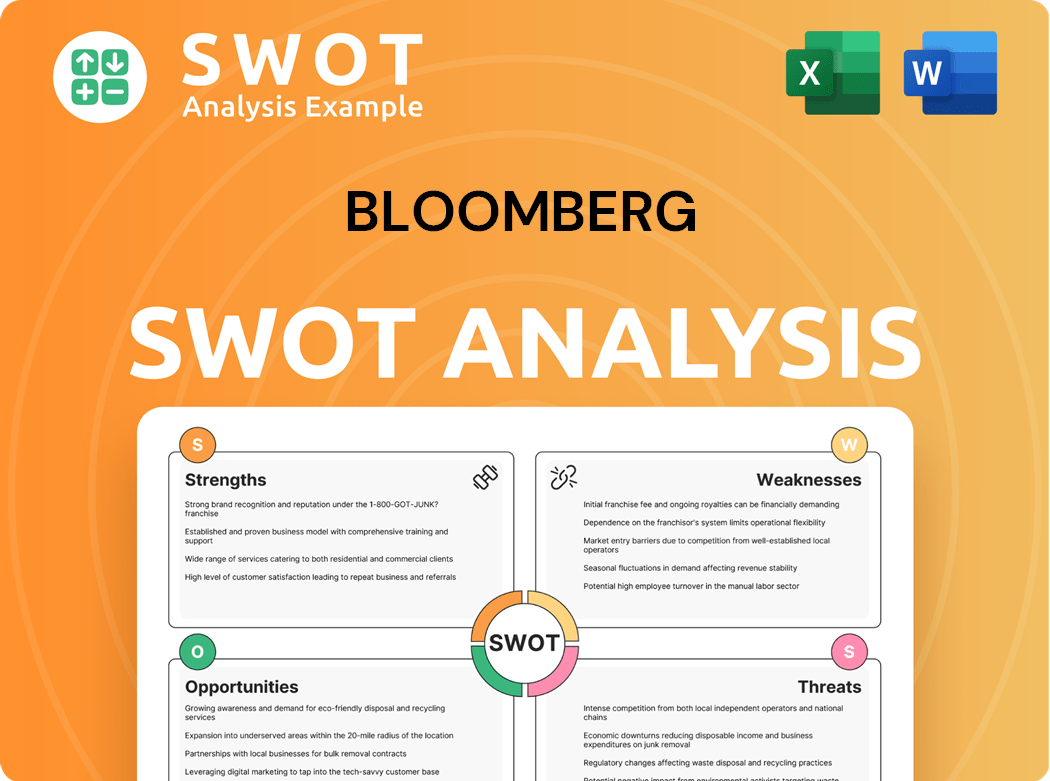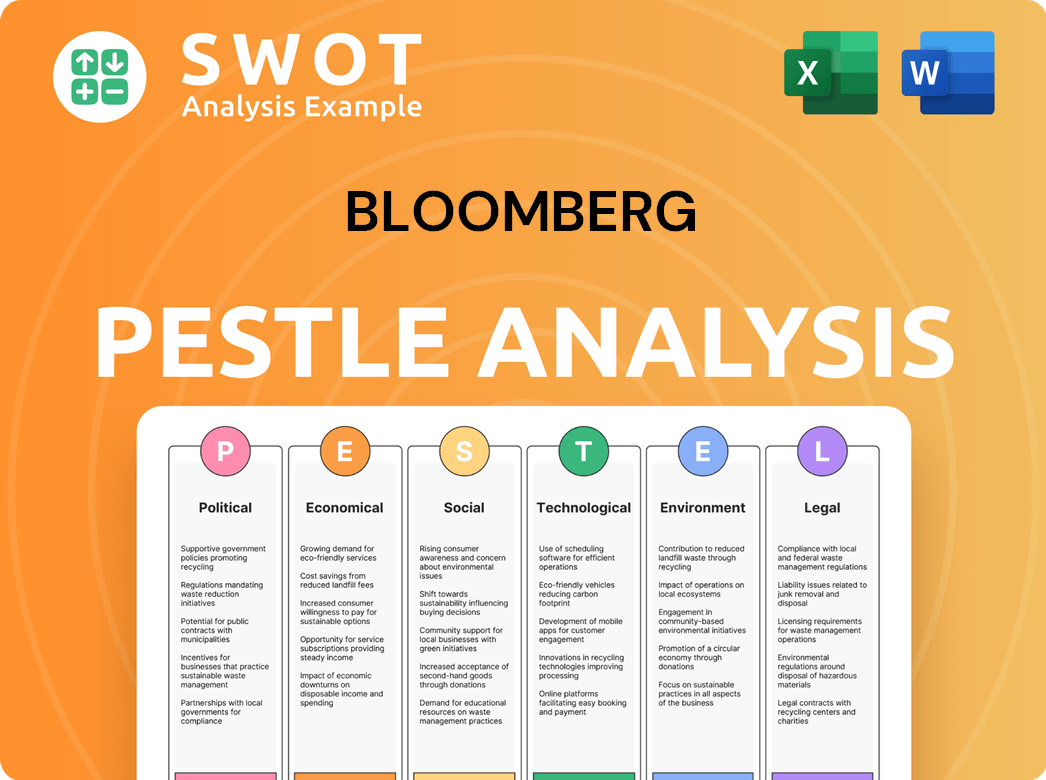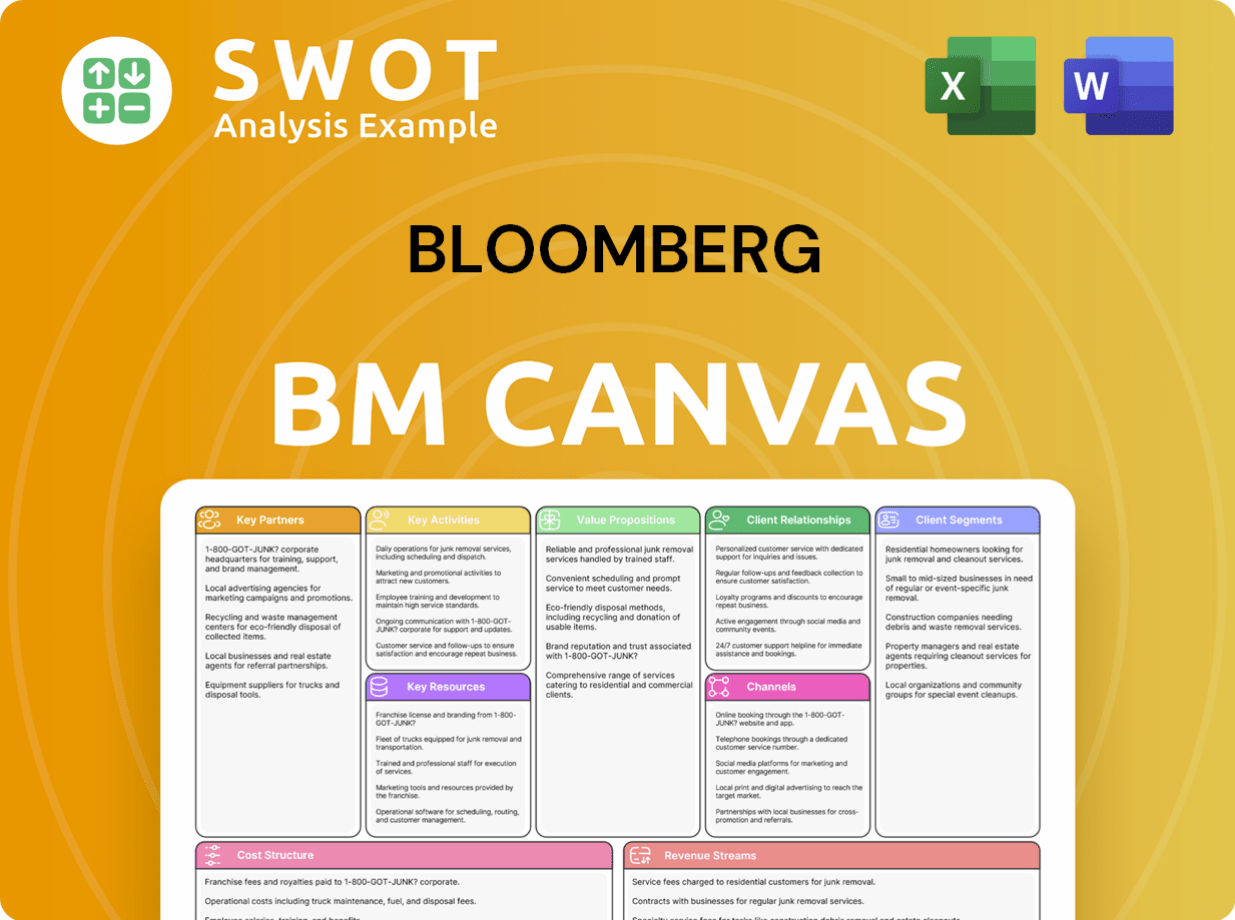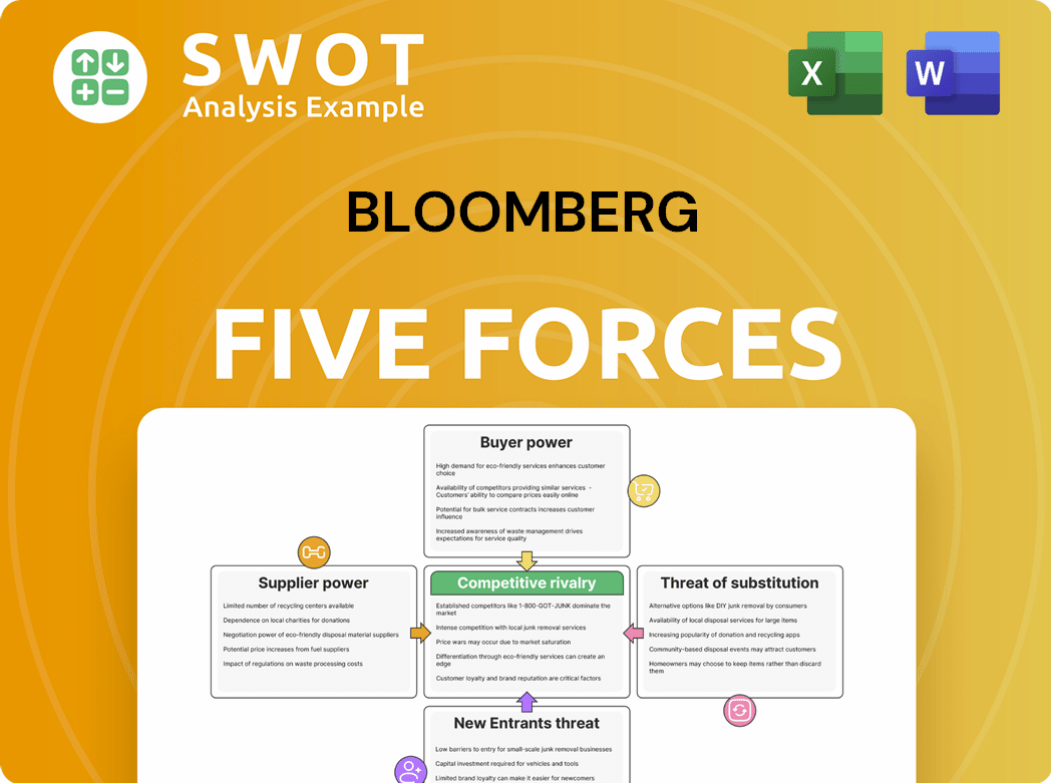Bloomberg Bundle
How Does Bloomberg Dominate the Financial World?
In the cutthroat realm of financial data, Bloomberg's sales and marketing strategies are legendary. From its inception, the company has revolutionized how financial professionals access and utilize information. This exploration delves into the core tactics that have cemented Bloomberg's position as a leading financial data provider.

Bloomberg's success hinges on a powerful combination of a robust Bloomberg SWOT Analysis, effective sales strategies, and innovative marketing. The company's unwavering focus on the Bloomberg Terminal as its flagship product has been pivotal to its growth and market dominance. Understanding the nuances of Bloomberg's business model, including its pricing strategies and customer acquisition methods, is crucial to appreciating its enduring impact on the financial landscape. This analysis will dissect Bloomberg's sales team structure, marketing campaigns, and competitive advantages to provide actionable insights for any business seeking to thrive in a competitive market.
How Does Bloomberg Reach Its Customers?
The sales channels of Bloomberg L.P. are primarily centered around a direct sales model. This approach involves dedicated sales teams who directly engage with financial institutions, corporations, government agencies, and individual professionals globally. This high-touch strategy is crucial for demonstrating the complex capabilities of the Bloomberg Terminal and other enterprise solutions, often requiring tailored demonstrations and integration discussions.
The company's website serves as a vital online channel for lead generation, providing detailed product information, case studies, and contact forms for sales inquiries. While not a traditional e-commerce platform for its core offerings, it functions as a digital storefront for content and initial engagement. The evolution of Bloomberg's sales channels has mirrored the increasing sophistication of its product offerings and the global expansion of financial markets.
Initially, sales were heavily reliant on in-person meetings and direct outreach to financial firms. As the company grew, it established regional sales offices globally, enabling localized support and deeper market penetration. Strategic shifts have included an increased emphasis on digital engagement for initial outreach and nurturing leads, though the closing of complex enterprise deals still heavily relies on direct sales interactions. For instance, in 2024-2025, Bloomberg continues to invest in its global sales force, recognizing the need for expert guidance in navigating the intricacies of financial technology solutions.
The core of Bloomberg's sales strategy relies on a direct sales model, with dedicated teams engaging clients worldwide. This approach is essential for demonstrating the complex features of the Bloomberg Terminal and enterprise solutions. The focus is on building relationships and providing tailored solutions for each client's needs.
Bloomberg's website serves as a crucial online channel for lead generation, providing detailed product information and contact forms. It offers a digital storefront for content and initial engagement, supporting the sales process. This digital presence complements the direct sales efforts.
Bloomberg maintains a global sales force to support its customers and expand its market reach. Regional sales offices enable localized support and deeper market penetration. This structure allows for expert guidance in navigating the complexities of financial technology solutions.
While direct sales are key, Bloomberg also engages in strategic partnerships for data feeds, APIs, and media syndication. These collaborations extend its reach into specific market segments and integrate its data into third-party platforms. These partnerships contribute to broader market share.
Bloomberg's sales strategy focuses on direct engagement and relationship-building with financial institutions and professionals. The company emphasizes its global sales force and digital channels to support its sales efforts. Understanding the target market of Bloomberg is essential for effective sales and marketing.
- Direct Sales: Dedicated teams engage with clients worldwide, providing tailored demonstrations and support.
- Digital Engagement: The website and online resources are used for lead generation and initial customer interaction.
- Strategic Partnerships: Collaborations extend reach into specific market segments and integrate data into third-party platforms.
- Global Presence: Regional sales offices provide localized support and deeper market penetration.
Bloomberg SWOT Analysis
- Complete SWOT Breakdown
- Fully Customizable
- Editable in Excel & Word
- Professional Formatting
- Investor-Ready Format

What Marketing Tactics Does Bloomberg Use?
The marketing tactics employed by the company are multifaceted, designed to build brand awareness, generate leads, and drive sales within the financial industry. These strategies leverage a combination of digital and traditional media to reach a diverse audience of financial professionals. The core of their strategy focuses on providing high-quality content and data-driven insights.
Digital marketing is a key component of the company's approach, with content marketing playing a significant role through its extensive news operations, research reports, and analytical insights. Search Engine Optimization (SEO) is essential for ensuring the visibility of its vast content library. Paid advertising campaigns on professional networks like LinkedIn and financial news websites target specific segments of financial professionals. Email marketing is used for lead nurturing, delivering personalized content, and announcing product updates.
Traditional media, though less dominant than digital, still plays a role, including its own TV and radio networks, which serve as powerful branding and content distribution channels. The company also participates in and hosts numerous industry events and conferences, providing opportunities for direct engagement with potential and existing clients, showcasing new features, and networking. The company's marketing mix has evolved significantly towards digital channels and data-driven personalization in recent years, reflecting the industry's shift towards digital consumption of financial information.
Digital marketing is the primary focus, with content marketing, SEO, paid advertising, and email marketing as key tactics. These strategies are designed to reach financial professionals where they spend their time online, ensuring high visibility and engagement. The company uses a data-driven approach to refine its digital marketing efforts.
Content marketing is central to the company's strategy, with its news operations, research reports, and analytical insights. This positions the company as a thought leader in the financial industry, attracting and retaining customers. The quality and depth of content are critical for building trust and driving engagement.
SEO ensures high visibility across its content library, while paid advertising targets specific segments of financial professionals. These tactics are essential for driving traffic and generating leads. The use of SEO and paid advertising is constantly optimized to improve performance.
Email marketing is used for lead nurturing, delivering personalized content, and announcing product updates. This helps to maintain engagement and guide potential customers through the sales funnel. The company uses email marketing to provide timely and relevant information.
Traditional media, including TV and radio networks, supports branding and content distribution. Participation in industry events provides direct engagement opportunities. These traditional channels complement the digital efforts, creating a comprehensive marketing approach.
Data-driven marketing is highly advanced, utilizing customer segmentation for personalized messages and product recommendations. This approach ensures that marketing efforts are relevant and effective. The company leverages analytics tools to optimize its marketing spend.
The company's marketing strategy is a sophisticated blend of digital and traditional tactics, with a strong emphasis on data-driven personalization. This approach aims to build brand awareness, generate leads, and drive sales in the financial industry. The company's success is rooted in its ability to understand and cater to the needs of its target audience.
- Content Marketing: Providing valuable financial news, research, and analysis.
- SEO: Optimizing content for search engines to increase visibility.
- Paid Advertising: Targeting specific financial professionals on platforms like LinkedIn.
- Email Marketing: Nurturing leads and delivering personalized content.
- Traditional Media: Utilizing TV and radio networks for branding.
- Events and Conferences: Engaging with potential clients directly.
- Data-Driven Marketing: Using customer segmentation for personalization.
Bloomberg PESTLE Analysis
- Covers All 6 PESTLE Categories
- No Research Needed – Save Hours of Work
- Built by Experts, Trusted by Consultants
- Instant Download, Ready to Use
- 100% Editable, Fully Customizable

How Is Bloomberg Positioned in the Market?
Bloomberg's brand positioning centers on delivering 'The Future of Finance' through superior data, news, and analytics. It distinguishes itself from competitors by emphasizing real-time accuracy and comprehensive coverage. The integrated nature of its flagship product, the Bloomberg Terminal, is a key differentiator. The company's brand identity is characterized by a sleek, professional, and data-centric aesthetic.
The brand's voice is authoritative and concise, reflecting the critical nature of the information it provides. Bloomberg aims to offer a customer experience built on efficiency, reliability, and actionable intelligence, enabling financial professionals to make informed decisions swiftly. This positioning is reinforced through consistent branding across all channels, from the Terminal interface to its news broadcasts.
Bloomberg's strategy emphasizes innovation and indispensability, with the Bloomberg Terminal often considered essential for financial professionals. It maintains a premium pricing strategy, reinforcing its high-value positioning. The company consistently ranks highly in brand perception surveys within the financial industry. For example, in 2024, Bloomberg continued to be recognized as a leading financial data and analytics provider. The Brief History of Bloomberg details the company's evolution and its impact on the financial world.
The Bloomberg Terminal provides real-time data, news, and analytics, offering a comprehensive view of global markets. It is designed to be an all-in-one platform for financial professionals. This integrated approach saves time and enhances decision-making capabilities.
Bloomberg differentiates itself through real-time accuracy, comprehensive coverage, and the integrated nature of its Terminal. The company's commitment to innovation and technological advancements, like AI and machine learning, further sets it apart. These advancements help in data analysis.
Bloomberg consistently receives high ratings in brand perception surveys, particularly for data quality and real-time news delivery. Its brand is associated with reliability and authority within the financial sector. This positive perception supports its premium pricing strategy.
The primary target audience includes financial professionals, such as traders, analysts, and portfolio managers. Bloomberg's focus is on providing tools and information that these professionals need to make informed decisions. The company also targets financial institutions.
Bloomberg's brand positioning is built on several key elements. These elements work together to create a strong brand identity and market presence. The company's success is a result of these carefully crafted strategies.
- Real-time Data and News: Providing up-to-the-minute information is crucial for financial professionals.
- Comprehensive Coverage: Covering a wide range of asset classes and markets ensures broad appeal.
- Integrated Terminal: The all-in-one platform streamlines workflows and enhances efficiency.
- Premium Pricing: Reflects the high value and essential nature of the service.
- Innovation: Continuous investment in new technologies keeps the company ahead of the competition.
Bloomberg Business Model Canvas
- Complete 9-Block Business Model Canvas
- Effortlessly Communicate Your Business Strategy
- Investor-Ready BMC Format
- 100% Editable and Customizable
- Clear and Structured Layout

What Are Bloomberg’s Most Notable Campaigns?
The sales and marketing strategies employed by Bloomberg have evolved over time, with a consistent focus on reinforcing its core product, the Bloomberg Terminal. The company's approach involves a blend of direct sales, thought leadership, and digital marketing to maintain its position as a leading financial data provider. This strategy has allowed Bloomberg to capture a significant market share and sustain its revenue streams.
Historically, the cornerstone of Bloomberg's marketing has been the Terminal. The objective is to position the Terminal as an indispensable tool for financial professionals. This is achieved through demonstrating its comprehensive capabilities and competitive advantages. More recently, Bloomberg has expanded its focus to promote new areas like sustainable finance and AI-powered analytics.
Bloomberg's marketing campaigns are designed to attract new client segments and highlight its evolving offerings. These campaigns often leverage digital channels, including targeted online advertising, webinars, and content series. While specific sales figures are proprietary, these campaigns contribute to increased engagement with newer product lines.
The primary sales strategy centers around the Bloomberg Terminal, emphasizing its comprehensive data, news, and analytics. This approach ensures the Terminal remains the go-to solution for financial professionals. The sustained focus on the Terminal has led to consistent subscription growth.
Bloomberg leverages digital channels, including online advertising and webinars, to promote its products. These initiatives aim to showcase the company's innovative offerings and attract new clients. This digital approach complements its traditional sales methods.
Bloomberg uses its media properties, like Bloomberg TV and Businessweek, for thought leadership and content marketing. This strategy reinforces its industry expertise and builds credibility. The content marketing approach supports its sales efforts.
Recent campaigns highlight Bloomberg's expansion into areas like sustainable finance and AI-powered analytics. These campaigns aim to attract new client segments and showcase the evolution of its offerings. This growth strategy broadens its market reach.
Bloomberg's sales and marketing efforts are crucial for its continued success. The company's focus on the Terminal, coupled with its expansion into new areas, demonstrates a strategic approach to maintain its market position. Bloomberg's ability to adapt its strategies, including digital marketing tactics, has been key to its sustained growth. To learn more about the company, see Owners & Shareholders of Bloomberg.
Bloomberg Porter's Five Forces Analysis
- Covers All 5 Competitive Forces in Detail
- Structured for Consultants, Students, and Founders
- 100% Editable in Microsoft Word & Excel
- Instant Digital Download – Use Immediately
- Compatible with Mac & PC – Fully Unlocked

Related Blogs
- What are Mission Vision & Core Values of Bloomberg Company?
- What is Competitive Landscape of Bloomberg Company?
- What is Growth Strategy and Future Prospects of Bloomberg Company?
- How Does Bloomberg Company Work?
- What is Brief History of Bloomberg Company?
- Who Owns Bloomberg Company?
- What is Customer Demographics and Target Market of Bloomberg Company?
Disclaimer
All information, articles, and product details provided on this website are for general informational and educational purposes only. We do not claim any ownership over, nor do we intend to infringe upon, any trademarks, copyrights, logos, brand names, or other intellectual property mentioned or depicted on this site. Such intellectual property remains the property of its respective owners, and any references here are made solely for identification or informational purposes, without implying any affiliation, endorsement, or partnership.
We make no representations or warranties, express or implied, regarding the accuracy, completeness, or suitability of any content or products presented. Nothing on this website should be construed as legal, tax, investment, financial, medical, or other professional advice. In addition, no part of this site—including articles or product references—constitutes a solicitation, recommendation, endorsement, advertisement, or offer to buy or sell any securities, franchises, or other financial instruments, particularly in jurisdictions where such activity would be unlawful.
All content is of a general nature and may not address the specific circumstances of any individual or entity. It is not a substitute for professional advice or services. Any actions you take based on the information provided here are strictly at your own risk. You accept full responsibility for any decisions or outcomes arising from your use of this website and agree to release us from any liability in connection with your use of, or reliance upon, the content or products found herein.